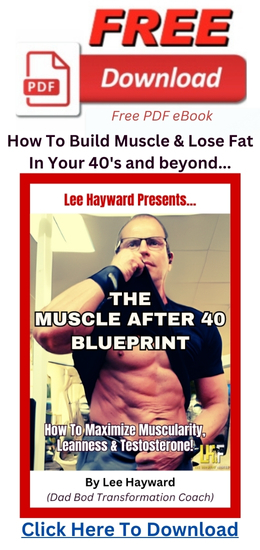21 Day Fast Mass Building Update #3:
Top 3 Muscle Building Mistakes Bodybuilders Make…
By Lee Hayward & Vince Del Monte
Your muscles grow on calories, correct? Of course. We all know you’re not going to pack on serious muscle size without an ideal consumption of muscle-building foods. In fact, without a certain amount of muscle-growing and nutrient dense foods you are at risk for losing the current muscle mass you already have.
This is probably why many newbie bodybuilders fall for the logic behind the “see food diet” that encourages you to eat anything within an arms reach if your goal is to grow big muscles.
I wish it was that simple!
|
Eating more food than your body requires will certainly make you a bigger person but it does not promise you’ll be a more muscular person! Too often we see young guys with great muscle-building potential ruin their physiques by eating excessive food quantities, even junk food, in the quest for stimulating faster muscle gains.
Unfortunately, if you’re a drug-free trainee your body has a limited capacity for growth. Each person can only produce so much muscle tissue based on his or her’s protein intake, genetics, testosterone levels, testosterone to cortisol ratio, insulin sensitivity, muscle fiber breakdown and many other factors. Bottom line: you can’t force your muscles into growth by simply overloading your muscles with more and more calories. Giving your body more than the ideal number of calories only results in your body to gain more body fat, not muscle. |

|
Bulking Up Then Cutting Down: Yes or No?
Let’s first admit that both cases are extreme approaches even though each method is the polar opposite. When you’re bulking your primary goal is to pack on size and mass without too much concern for extra fat gain.
This is a period of time you eat everything within arms reach and some even employ force feeding yourself. You eliminate your cardio and any activity that might stall your weight gain. Your success is dictated by how much the scale goes up, with minimal concern for your appearance.
The rationale is that you’ll be able to diet off the fat later. Your next goal is a cutting phase where the objective is to strip as much fat as possible. This is accomplished by increasing cardio, restricting your calories and introducing more physical activity to accelerate the fat loss process.
Problem #1:
You can’t force your muscles to grow. Muscle growth occurs in spurts.
Bodybuilders will routinely go from heavy “Off-Season” mass building programs, to ultra strict “Pre-Contest” fat loss programs, as well as taking some down time where they settle into more generic maintenance style cruising programs.
You see building muscle happens in spurts. It’s kind of similar to the seasons in nature; you have the planting season of the spring, the growing season of the summer, the harvesting season in the fall, and then some down time over the winter.
Muscle building works along the same lines, it is NOT a non-stop process that just goes on and on forever without interruption. You have to work WITH your body, not against it. If you are stubborn and try to force your body to grow non-stop it will fight back with all the negative training symptoms of plateaus, over training, burnout, and injuries. You may have already experienced some of these things first hand for yourself, or at least know of people who have.
However the 21 Day Fast Mass Building training cycle avoids many of these pitfalls by providing variety and unique muscle stimulation. It also takes advantage of the body’s natural anabolic growth and recovery cycles and uses them to maximize muscle growth.
|
Problem #2: Simply eating more food won’t always lead to more muscle growth. Instead it’ll add more weight but in the form of body fat. You might be thinking… “So what? I’m going to cut the fat later and it’s only on my body for a few months…” Here’s a brief summary of the health problems you can’t escape from bulking that results in excessive fat: |

|
1. Insulin-resistance.
First things first…
Low insulin resistance is good. Insulin resistance is bad. Low insulin sensitivity is bad. High insulin sensitivity is good.
Those two terms used to confuse the heck out of me! Better insulin sensitivity is also known as nutrient partioning effect which simply refers to forcing the nutrients you consume get shuttled into your muscle cells and not into your fat cells.
Your entire nutrition program and training must be designed around shuttling ingested calories away from fat stores, and direct them into muscle. Makes sense, right?
Let me break it down a tad further:
When you’re in caloric excess, calories can either go into muscle or fat. When dieting, calories can either be pulled out of fat or they can be pulled out of muscle. Someone with good partitioning and a high metabolic rate is easily able to pull and utilize energy from fat, and direct energy into muscle.
TAKE HOME MESSAGE: the key to a clean and healthy bulk is nutrient partitioning, and the lower your bodyfat the better your body becomes at nutrient partioning (see how this all ties together?)
Ever wonder why physique competitors continue to get leaner and more muscular each year while the majority of gym goers pretty much look the same? It’s because every time you compete you lower your percentage body fat and that makes your body better at nutrient partitioning.
Physique competitors become more effective at storing ingested nutrients in the muscle (as muscle tissue or glycogen) or in the liver (as glycogen) and less effective at storing nutrients as bodyfat.
Here’s a picture of Vince (Far right) from his first fitness show in 2005. Lean and mean – He was 171 pounds and 5% in this picture:

Here is Vince is in 2008 – 3 years later- at around 196 pounds and 6% fat at the same show – FAME World Championships in Toronto. Staying lean helped Vince gain muscle size from show to show.

Having Excess BodyFat Will Decrease Muscle Gains
We now have research to support that it is unquestionably clear that higher fat levels can decrease muscle gain.
Want to see the evidence?
Forbe’s Theory: In 1980’s, Forbe’s showed that there is a logarithmic relation between fat gain and lean body mass gain. He showed that the extent of LBM gain or loss depend on the initial body fat in humans and other species.
Basically, lower your bodyfat, better your muscle gains when you overeat. As you put on more fat, your muscle gains tend to decrease. Lean people show 30-70% of LBM gain and obese people show 30-40% of LBM gain with overeating.
Anecdotal Evidence: There has always been some anecdotal evidence that natural folks tend to gain the most muscle at 10-15% body fat. Beyond 15%, you tend to gain more fat and less muscle.
How and why in the world does this happen?
|
Insulin Resistance: The decrease in muscle mass with increasing fat can largely be attributed to the insulin resistance in the muscle with increasing fat accumulation. The recent animal study was the first to show that increase fat levels can directly blunt muscle protein synthesis via the insulin pathway. Mice fed a high fat diet and loaded (akin to weight training) for 30 weeks. The mice in high fat group put on 31% more weight than the low fat group.
The results showed a significant decrease in the muscle mass and the activation of key members of the muscle growth pathway in the high fat group. (It’s an animal study so take it with a grain of salt). |

|
Next we have…
2. Fat cell hyperplasia.
Another problem with bulking up is fat cell hyperplasia. Here’s what we learned from muscle-building expert, Christian Thibaudeau:
“You can add size or volume to a structure either by making the existing components bigger (hypertrophy) or by increasing the number of components (hyperplasia). This holds true for fat cells.”
|
Fat cells (adipocytes) are like little bags. The more fat you put in the bags, the bigger they get. However, the bags can only hold so much fat. But lucky for us (or not) our body is a fantastic storage machine built for survival. As a result, it can also increase fat storage by adding more fat cells. The more fat cells you have, the easier it is for your body to store fat. This is where the problem comes in.
When overeating for a significant period of time, your body increases its number of fat cells. While you can make the existing fat cells “smaller” by emptying their fat content (fat loss), it’s impossible to remove fat cells without surgery. So your body can add fat cells, but it can’t remove them… |

|
This is a big problem: the more fat cells you have, the easier it is for your body to store fat. So by adding new fat cells to your body you’re actually making it better at gaining body fat as well as worse at losing it! By following an all-out bulking approach, you can stimulate adipocyte hyperplasia, which will make it harder to lose fat and easier to gain it over time.
3: Bulking up can ramp down the power of your thyroid hormone production.
If you know anything about fat loss you know this is not good.
We learned this one from Charles Poliquin too and he was quoted as saying:
“Thyroid production is essential for fat loss. The fatter your abdominal wall becomes, the less conversion there will be of T4 to T3, the metabolically active form of thyroid.”
Here’s what I’ve personally discovered: You can get away with a traditional bulk up/cut down cycle, maybe a few times in your life.
As you train longer and become more experienced, eventually you’ll hit a point that overshooting your goal ripped look before cutting becomes more and more challenging as you get closer to your natural genetic potential.
| Let’s say your first bulk was from 150 to 200 and then you cut down. If it was your very first transformation then I’m guessing the majority of that 50 pounds was lean muscle and you only had 10 or so pounds of fat to cut? No problem. Most of your gains are muscle so your thyroid hormone should be charged to the max.
The end result is a lean 190 pounds. This situation is very similar to how Vince Del Monte’s first physique transformation went. |

|
Let’s say now you want to go from a lean 190 pounds up to a lean 220 pounds. In order to do this you’ll probably have to bulk to 240 or 250 and then diet back down to end up at a lean 220. It’s going to take longer to cut 20 or 30 pounds of fat instead of cut 10 pounds of fat.
Can you see a problem?
More time cutting results in less time bulking and less time bulking means less overall muscle mass.
Another hidden problem with cutting cycles is that the longer you cut the greater the chances of losing muscle due to the caloric deficit. This is definitely not what you want.
Problem #3:
Bulking can become overwhelming and not practical (for some).
Bulking for four to six months at a time can be an intimidating and daunting goal. Often times, guys can’t commit to the grocery bill, meal prep time, cooking time and constant meal feeding. They begin seeing some decent muscle gains but soon hit a plateau and find the only scale weight that continues to increase is fat.
There is a mental benefit to breaking down your large goals into smaller chunks that can be more appealing and realistic for most people to commit to. With the 21 Day Fast Mass Building System, instead of a 12 week bulking / cutting phase you only have to focus on a 2 week overload phase and a 1 week primer phase with our new method.
Mentally and physically it’s easier to follow a short high energy 21 day program rather than a monotonous 12 week long program. Plus you’ll make faster gains with shorter programs when you’re compliant to the training and diet.
SUMMARY POINTS:
- Don’t get fat. If you’re a competitive bodybuilder than your bodyfat should never go over 10% fat all year round. If you never plan on stepping on stage than your bodyfat should never go over 15% all year round, even during bulking cycles. Anyone can maintain 10% – 15% bodyfat. These are not high standards by any means and I like these numbers because you’re always within a few weeks from being in super lean shape.
- Your body develops muscle in spurts and trying to “force feed” your body into growth will only work for a certain period of time and result in poor health, bad habits, excessive fat and ruin your physique.
- Staying lean will helps you grow muscle better through nutrient partitioning. Packing on fat only makes it harder to lose it later on. Remember, lean people are more efficient at storing their digested food in the muscle (as muscle tissue or glycogen) or in the liver (glycogen), and less efficient at storing them as body fat. In plain english, lean people can eat more food with less chance of getting fat.
- The fatter you get, the more fat cells you accumulate in your body. This makes losing fat harder in the future, and that does not even factor in the less insulin sensitive you become. This is why lean people have an easier time staying lean and why fatter people seem to be up against a losing battle.
- Your muscles do grow on calories but this isn’t rationale to eat junk-food and don’t ever fool yourself into thinking that pizza, chicken wings and donuts will equal the same muscle growth as brown rice, chicken, and fish. It’s true, many times lifters don’t eat enough to promote maximum muscle gains, but allowing your self to get fat is not the plan you should follow. If you’re not growing then most likely you’re not eating enough but never take the easy way out and resort to low-quality junk food.
Questions? Comments?
Leave them below and Vince and I will hook you up with answers.
all the best,
Vince & Lee







23 Comments
frank
what if i do get my extra fat cells surgically removed and then start off fresh by not overeating? will i fit in the lean mans category where it’ll be harder for me to gain fat?
Thomas J Ahern(Irish)
I have Diabetes.My Diabetic Dr knows that I workout.I was told by him that insulin
makes you gain wt.Do you know if this is True?I never workout until failure because I can’t tell the difference between that feeling & low-sugar feeling.
Tom Ahern
Will
Hi Lee & vince
Thankyou for this article; it put my mind at ease about concerns i had about bulking up like a lot of my weightlifting friends and thus loosing my lean soccer player physique . I am currently looking to build a decent mass building program and was wondering if you could email me the 21day program PDF.
Thankyou!
p.s. Keep your tips vids n hints coming i am like a tomb of knowledge to my friends paraphrasing you guys 🙂
michael iantorno
HI LEE AND VINCE, great artical i never did believe in BULKING, for the reasons that lee explained, and also i am a endomorhp and cannot afford extra BF– and i also need a lot more cardio then my counter parts and keep a close eye on my nutrition.
PS, i am looking into doing a BB competition and purchased lee’s book– “FIRST BODYBUILDING COMPETITION” wish me luck.
leehayward
Yes, but this is the extreme approach. However, it certainly does work and it is sometimes required when people are extremely obese and diet and exercise are not enough to get rid of the excess fat and loose skin.
leehayward
Insulin is a double edged sword it can help you gain lean muscle when the nutrients are shuttled towards muscle growth. But it can also make you gain fat if the nutrients are shuttled towards bodyfat. This is what we cover in the article above with regards to insulin sensitivity and insulin resistance.
leehayward
Cool, glad you like the tips we share. The actual 21 Day Fast Mass Building Program will be available on January 11th. But in the mean time we are going to be sharing some more info about what it’s all about and how it works right here on the blog.
Mr.faty
could you email me the insuline tric btw am 15 lot of mass but got 6% fat and it destroys evry single hard working minit am doing cardio program 3 times a week and 3 lift i have my muti v and proitein shakes good nutrition but no abs you see fatt **** up evrything HELP pls
Ryan Philipson
good article Lee and Vince, but i have a question that its a bit off the topic.
We all know how to stilumate muscle hypertrophy, but how about stimulating muslce hyperplasia, how can we go about it??
Miguel
Thanks Lee and Vince for this very informative newsletter. Please know that sharing this remarkable info is greatly appreciated by your audience. Thanks so much guys!
Chris
i am at a plateau right now. is it because i dont eat right? i change up my excersices every week but ill admit it…. i eat alot of fat to get bigger (well not a lot of fat) i have been at this plateau for a month now and i am getting really tired of it.
Nilabjo Banerjee
hi lee and vince
amazing website. i am currently at 16% body fat 5 8 and 175 lbs.. goal is to get lean to about 10% body fat in next 90 days. so does that mean i should worry about applying these principles AFTER i get to 10% body fat..
nki
I have a very lean physique and always have been, thats just my body type. So according to what you have said, if I bulk, eating lean calories, I would just gain muscle right? I mean thats the program Ive started to pursue, but Im afraid of gaining fat because I’m already at a low percentage, and I dont want to ruin that. Am I okay?
Tyler
I doubt you get a adipocyte hyperplasia. the real problem is, is when fat cells aren’t stuffed they produce good things like leptin, and adiponectin which increases insulin sensitivity; however, when these fat cells get stuffed they stop producing adiponectin and produce proinflammatory cytokines like TNF alpha and the list goes on and on as how “skinny” fat cells are very healthy and “fat” fat cells are really deadly.
Vijay
I have always been a big guy weighing about 110kg. Have always been regular with the gym and tend to go about at least 3 times a week. At the same time I do play soccer as well. But the problem is I have not been able to reduce my body weight. This has been an issue for ages now. I have also seen a doc about this and he was mentioning it was also due to genetics. Is there a way which I can overcome this and feel better about my self. I don’t really want to bulk up my self since I am already on the bigger size. I would like to tone down and feel better about my self. I have also been strict with my food but nothing is helping me much. Is there any supplements which you could recommend for me to achieve my goals. Thanks
Halston
hey lee and vince
I am 21 and have messed around with training since I was 13, but I have been training consistently for the last 2 years with only minimum results. I’m almost certain that the main problem is that I am not eating enough. I eat a fairly clean diet but I can’t ever seem to get in more than like 3 meals, a snack, and a protein drink. How can I get in 5 or clean meals a day, everyday?
Thank you for your time
Tyler
Ryan Philipson,
Hyperplasia is quite uncommon in adults and very hard for it to occur. However, there have been studies that show that hyperplasia can occur even at high percentages by doing certain things that aren’t very safe. One is the chronic stretch with weight, and the other is extreme eccentric lifts. Indirect fiber counts employing histological cross-sections and nitric acid digestion suggest that these exercises induce fiber hyperplasia, in which satellite cells appear to be involved.
hope that helps.
Desmond Duignan
The main tv station in Ireland, RTE, runs an 8 week tv programme called Operation Transformation, it is now in it’s 3rd or 4th year. Overweight members of the public apply to be picked as one of 5 leaders. Together with a panel consisting of a doctor, nutritionist and a fitness trainer they each aim to loose weight over the 8 week period. It is aired weekly. They take them on assault courses with army fitness instructors, teach them healthy eating and lifestyle, etc. It is worth having a look at, you can follow it on the RTE website at http://www.rte.ie/ot
Perhaps yourself and Vince could get a similar tv programme going over your end of the world.
leehayward
There’s a theory that extreme stretching when the muscles are fully pumped can help create hyperplasia, in fact I’ve incorporated that into my Blast Your Biceps program. John Parrillo wrote a lot about extreme stretching back in the 90’s and I have to say that this is one technique that I’ve personally found help me make some good gains in muscle size and fullness.
Now with that being said, I’ve never hired a team of scientists and doctors to try do studies and see if the muscle growth was from hypertrophy, hyperplasia, or whatever, I just know that I’ve gained muscle from using the techniques.
leehayward
When you are stuck in a plateau you need to do something different. Keep doing the same things, you’ll keep getting the same results. You need to think outside the box. Maybe the 21-Day Fast Mass Building Program could be just what you need. Check it out for yourself and see if it feels right to you…
leehayward
You can actually follow the 21-Day Fast Mass Building Program at 16% bodyfat. I’ve customized different guidelines to follow with setting up your nutritional protocols for people who are under 10%, people who are between 10-20% and for folks who are over 20%. Basically you’ll adjust your calorie and nutritional needs based on your specific body type.
leehayward
When ever you over eat in effort to gain muscle, you risk gaining some fat. That’s why we take the 2 steps forward and 1 step back approach. Not only does it optimize your anabolic hormones, etc. but it allows you to burn off any fat you do gain while priming your body for the next mini growth spurt. It’s all outlined in detail how it works and how to follow this in the 21 Day FMB program.
Tyler
Hyperplasia is quite uncommon in adults and very hard for it to occur. However, there have been studies that show that hyperplasia can occur even at high percentages by doing certain things that aren’t very safe. One is the chronic stretch with weight, and the other is extreme eccentric lifts. Indirect fiber counts employing histological cross-sections and nitric acid digestion suggest that these exercises induce fiber hyperplasia, in which satellite cells appear to be involved.